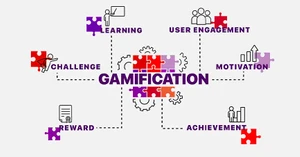How Has Gaming Industry Evolved Over the Years
The market for gaming development is expected to grow at a high CAGR in the coming years. All thanks to the mass usage of smartphones and the access to high Internet bandwidth. The common misconception around gaming is that school students download and play video games the most. However, the truth is that the love for games is to be found in professionals, stay at home parents, and even the older generation.
The gaming industry so far has only ballooned and there are no signs of it slowing down. Across the world, there are more than two billion gamers, says the Global Games Market Report of 2019. There continues to be a steady rise of over nine per cent every year in terms of the number of people spending time with gaming.
Technological developments like IoT, AI and VR realities too have made the gaming industry a profitable venture. Revenue wise the statistics are jaw-dropping too. In the year 2019 itself, this industry earned a revenue of over thirty-five billion. Mobile gaming and Console dominate the market today. Although PC game segment is moving at a bit slower pace presently.
What is Video Game Development?
Video game development is a multi-stage process involving the design and development of a game before its final release. Starting from visualizing a game design to developing and testing it before doing a beta release and the final release, these are the critical stages of game development.
Game development is a technical and creative art that involves multi-pronged production, designing, ideation, assessment, examination and development strategies. Through coding, renderings, sound effects and more, a video game is brought to life. Game developers also have to consider the strategies to keep players engaged, rewards for them and other game mechanics.
What are the Different Components of Game Development
Objectives- Skill, knowledge and attitude are the learning objectives that a player should be able to establish while playing a game.
Interactivity- Interactivity is important so that gamers can experiment with their knowledge and ideas in a game.
Rules & commands- game developers need to set proper commands and rules so that players can follow them if they have to succeed.
Competition and differences- A game has to be challenging so that gamers do not get bored and are always on the lookout for ways to win new battles.
Feedback or result- This factor helps a player assess her or his performance in a game and improve next time.
What Programming Languages Are Used for Game Making
C++ programming language is used for playing Console and Windows games. Java is another programming language used for more complex game scenarios. Other languages that are used in game development include CSS3, SQL, JavaScript and HTML5.
What is Best Game Development Software
Game development software is a specialized platform for developing, testing and releasing video games. Game development tools depend on 2D and 3D textures and models for developing video games.
Game development software can be used for creating games for PC, mobile and Consoles. Game designing software is used to create all the major game components and set the speed for rendering graphic elements. Different tools for game development apply the lay of Physics to create professional-level graphics.
What Tools Are Used for Game Development
Video game software provides an array of 3D model tools along with objects, items, terrain, behaviour and environment. Also, there are real-time and level editor tools for checking how an object would look like when seen in a game. Game developers commonly use the following game making software for PC and mobile.
Best Game Making Software for PC & Android
GDevelop: GDevelop provides support to native games and HTML 5 for building games without requiring any programming knowledge. The game-making software offers sprites, custom shapes, video and text objects for developing stunning games. The app's inbuilt screen editor is designed to make game editing easy at every level.
Autodesk: Autodesk game development software provides versatile tools for doing editing, content creation, and animation. The game maker is customizable and offers modules for rigging, rendering, modeling, and exporting. You also get this option for integrating Autodesk with your game development pipeline.
Unity: Unity game development suite with its built-in versatile editor supports rapid development of games, which can be later on published on other platforms like mobile, VR, desktop, etc. The game development software is ideal for building logic and top-quality gameplays and provides a robust Play mode for monitoring the effects of iterations done. Unity editor gives you access to all tools like graphics, content creator and a versatile environment for accelerating workflows.
Best 2D and 3D Game Development Software
Stencyl: Stencyl game development software offers comprehensive and intuitive toolsets for accelerating the game development process. Create stunning 2D games with Stencyl's code-free drag and design concept.
Construct 2: Construct 2 is an ideal game-making software for developing 2D/3D HTML 5 impressive games without deploying any code or programs. The versatile platform offers a layout editor and an image editor for modifying an object's graphics. Construct 2 unique selling point is its inbuilt Physics engine.
GameSalad: GameSalad is an intuitive and powerful 2D game maker supporting this single click drag and drop environment for coding-free game development. The game development tool offers a visual programming interface along with a physics simulator for adding collisions and realistic motions to games.
How Does Game Making Software Facilitate Game Development
Game development software firstly provides codes for a game's elements and concepts. The software application also provides premade functions for different gaming genres. Premade functions and codes can be used for adding character movement to the game elements.
In the case of non-player backgrounds, there are multiple program and graphic frameworks. Key features that you get with game-making software are gameplay mechanics, RPG maker (template-based), long programming codes, and background templates.
Every game-making software is unique and a developer has to pick the right platform depending on the game genre and the platform like mobile or PC.
Most Common Features of Game Development Software
Animation: Game development tools are critical for adding animations to games and customizing these later on during game development stages.
Code-free development: Many game development software solutions offer code-free visual interfaces for developing wizards and creating games.
Integrated development environment: An integrated development environment is necessary as its graphical interface supports code compiling, debugging, and testing.
Physics simulation & prototyping: Game-making software supports prototyping and physics simulation for implementing the law of physics into a game.
Social competitive capability: Game making apps provide social competitiveness so that players can add their contacts for playing interactive games.
Scene designer tools: Scene designer tools like zooming selection, grid-snapping and flood flow allow for the manipulation of characters and terrain.
Screen editor: Game development software provides an inbuilt screen editor for editing the behaviour of objects at all levels.
Responsive manipulation: Responsive manipulation in game making software allows for creating realistic 3D models for animation purposes.
Interactive fiction: Game development software can be used if required for building non-linear, text-based games and visualizing the storylines.
What Are the Benefits of Game Making Software
Easy to create games: Game making software provides predefined templates and a graphical interface for reducing the time and resources spent in building a game.
Improved collaboration: Game programming software offers collaboration tools like live chats, asset and time management for managing the game development team's performance.
Better creativity: Game making platforms are ideal for the process of game designing and development with the help of advanced tools for scene ideation, character creation, graphics, background, etc.
A booming industry: The online gaming industry is fast developing and the demand for games is higher than ever. Game making software through automation tools makes the job of game developers much easier so that they can meet the expectations.
2D and 3D designs: Game development software offers high-quality design tools for building games belonging to different genres. While 3D games create an immersive experience for players and give them the freedom to act as per their skills, 2D games are for beginners with simple interface and simple controls.
Play mode for accelerating workflows: Popular game development tools provide the play mode for monitoring the effects of iterations thereby in real time to accelerate the workflows.
Build top-quality games: Game making software offers top-quality logic in games for creating a game's environment, characters, and functions.
Object editors: Game making software applications have an inbuilt object editor with a single click interface for manipulating the gaming objects.
What Is the Difference Between Game Development & Game Design
Game designers are concerned with the layout and design of a game whereas gaming developers turn those designs into the final product.
Game designers conceptualize a game and decide its overall functionality. Game developers use their skills and creative talent to bring to life these conceptualizations.
Game designers prepare a design plan by following the recent trends. Game developers deploy codes and programs to build games.
Game designers can build storylines, scenery, character, and designs for the games. Game developers create games for a specific kind of gaming console.
Factors to be Considered When Selecting Online Game Development Software
Cost of the software: The cost, features offered, and overall value of the game development software must fit your budget. Plus, the software must cater to your gaming requirements as the right application would go a long way in helping you establish a successful game development journey.
Connect with existing users: Those with experience in using a particular game development software could guide you to make the right choice. Speak to professionals who have used specific platforms and collect their feedback.
Functionality: Game making software offers both advanced and basic features. Make sure you go through the functionalities available to ensure that these suit your business requirements and workflows.
Compatibility: A gaming making platform that is compatible with your existing set up is like icing on the cake. Go through a software's credibility and compatibility scores for sure.
Security: Security features are essential for protecting the gaming prototypes, designs, and data, from falling into the wrong hands.
Exit strategy: Game making software with a clear exit strategy will save you from vendor lock-ins in case the application no longer fits your business model.
License suitability: These are additional but important factors that need to be considered like license requirements, user interface (friendly or not), terns and conditions, suitability, scalability, and integration.
Third-party integration: Game making systems often work in collaboration with other tools for video editing, animation software, audio mixing software, etc. Make sure that the software you choose for game development is compatible with your existing game making setup.
Relevant Game Making Trends
Augmented & Virtual Reality: Augmented and virtual reality are the two mainstream technologies that have been helping game developers add a simulated environment to their games. VR and AR reality supports haptic feedback and 3D space in an artificial environment for facilitating user interaction. These technologies have made it possible for gamers to experience virtually a real-world environment.
Game Streaming or Cloud Gaming: Cloud gaming or game streaming doesn't require any software installation and works perfectly fine on a reliable internet connection. Cloud gaming is done on remote servers and gamers experience the fun of playing games on their own devices.
Game streaming doesn't require any beefy consoles or smartphone devices, just a stable internet connection is enough. Cloud gaming services are subscription-based and are portable in the sense that you can start a streaming session as per your place and time zone preference.
Shift to 3D gaming: The three-dimensional video game industry is rising given the effective marketing strategies and higher buying power of gamers. Advanced gaming console strategies and affordable 3D display technologies are the other reasons why there has been a shift of interest from 2D to 3D games. Plus, real-time playing experience with realistic visual display, gamers couldn't have asked for more.
AI in Gaming: AI has made its foray into playable games and game developers are exploiting this to build intelligent and immersive games. Cutting-edge artificial intelligence research is being increasingly deployed to build more sophisticated games.
The technology aids in doing revisions, making value additions, and undertaking player profiling within a game's framework. AI-based techniques have helped with pathfinding too so that games characters get a lively appearance and the gaming experience is fast-paced.























